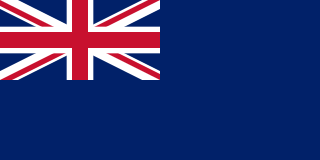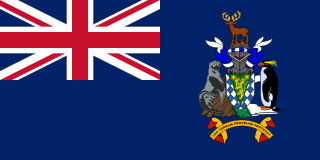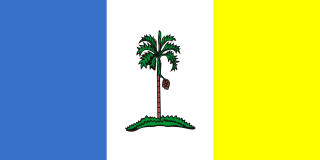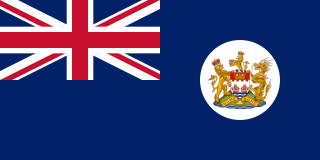

The flag of Weihaiwei was the flag used by the British leased territory of Weihaiwei during British rule between 1903 and 1930. The flag consisted of a British blue ensign with an emblem containing a pair of Mandarin ducks.


The flag of Weihaiwei was the flag used by the British leased territory of Weihaiwei during British rule between 1903 and 1930. The flag consisted of a British blue ensign with an emblem containing a pair of Mandarin ducks.
In 1898, the Empire of China leased the port of Weihaiwei (威海衛) to the British Empire for 25 years. During the first few years, there was no individual flag for Weihaiwei. However, the Commissioners of Weihaiwei in Liu-kung Tao (劉公島) used a Union Jack combined with a badge of a Chinese imperial dragon on a yellow background. [1] In 1902, the new civil Commissioner for Weihaiwei James Stewart Lockhart wrote to the Colonial Office requesting a new flag for the territory as he felt that it was inappropriate to use a Chinese national symbol on a British flag and suggested using Mandarin ducks instead. [2] (The Flag of the Qing dynasty at the time was a dragon on a yellow background). He wrote to them stating:
"The design of the flag hitherto used by the Commissioner of this Dependency is a dragon on the Union Jack and is in my opinion quite unsuitable. I have therefore to request that the Crown Agents may be instructed to have made for the use of the Commissioner two new flags, the device of the Mandarin Duck being substituted for the Dragon, which is as you are aware the national emblem of China and not appropriate in the case of a British Dependency". [2]
Following the letter, King Edward VII approved the change of design of the flag for both the Commissioner's flag and the blue ensign in 1903. He also provided for the flag to be used for merchant shipping as the merchant ensign. [3] In 1930, when the lease did expire following negotiations with the Republic of China, it was the British flag that was lowered at the handover ceremony and not the flag of Weihaiwei. [4]
The flag was designed as a British blue ensign defaced with a badge of two Mandarin ducks. The ducks consist of a male in the foreground and a female in the background drinking from a stream while standing on a reed-covered bank. [5]
Mandarin ducks were chosen to replace the Chinese imperial dragon on the flag, in keeping with the British colonial tradition of using representative common local wildlife of a specific territory as the emblem on its colonial flag. [3]

The Union Jack, or Union Flag, is the de facto national flag of the United Kingdom. The Union Flag was also used as the official flag of several British colonies and dominions before they adopted their own national flags. The flag continues to have official status in Canada, by parliamentary resolution, where it is known as the Royal Union Flag.

The flag of Newfoundland and Labrador was introduced in 1980 and was designed by Newfoundland artist Christopher Pratt. The flag design was approved by the House of Assembly of the province of Newfoundland, Canada, on May 28, 1980. It was flown for the first time on Discovery Day, June 24, 1980. The name of the province was changed to Newfoundland and Labrador by an amendment to the constitution of Canada in December 2001 at the request of the provincial legislature.

The national flag of Sierra Leone is a tricolour consisting of three horizontal green, white and blue bands. It was adopted in 1961, Sierra Leone's independence year, to replace the British Blue Ensign defaced with the arms of the Crown Colony of Sierra Leone.

The Red Ensign or "Red Duster" is the civil ensign of the United Kingdom of Great Britain and Northern Ireland. It is one of the British ensigns, and it is used either plain or defaced with either a badge or a charge, mostly in the right half.

In British maritime law and custom, an ensign is the identifying flag flown to designate a British ship, either military or civilian. Such flags display the United Kingdom Union Flag in the canton, with either a red, white or blue field, dependent on whether the vessel is civilian, naval, or in a special category. These are known as the red, white, and blue ensigns respectively.

The flag of Hong Kong, officially the regional flag of the Hong Kong Special Administrative Region of the People's Republic of China, depicts a white stylised five-petal Hong Kong orchid tree flower in the centre of a Chinese red field. Its original design was unveiled on 4 April 1990 at the Third Session of the Seventh National People's Congress. The current design was approved on 10 August 1996 at the Fourth Plenum of the Preparatory Committee of the Hong Kong Special Administrative Region. The precise use of the flag is regulated by laws passed by the 58th executive meeting of the State Council held in Beijing. The design of the flag is enshrined in Hong Kong's Basic Law, the territory's constitutional document, and regulations regarding the use, prohibition of use, desecration, and manufacture of the flag are stated in the Regional Flag and Regional Emblem Ordinance. The flag of Hong Kong was officially adopted and hoisted on 1 July 1997, during the handover ceremony marking the transfer of sovereignty from the United Kingdom back to China.

The national flag of the Commonwealth of The Bahamas consists of a black triangle situated at the hoist with three horizontal bands: aquamarine, gold and aquamarine. Adopted in 1973 to replace the British Blue Ensign defaced with the emblem of the Crown Colony of the Bahama Islands, it has been the flag of The Bahamas since the country gained independence that year. The design of the present flag incorporated the elements of various submissions made in a national contest for a new flag prior to independence.

The flag of Uganda was adopted on 9 October 1962, the date that Uganda became independent from the British Empire. It consists of six equal horizontal bands of black (top), yellow, red, black, yellow, and red (bottom); a white disc is superimposed at the centre and depicts the national symbol, a grey crowned crane, facing the hoist's side.

The Blue Ensign is a flag, one of several British ensigns, used by certain organisations or territories associated or formerly associated with the United Kingdom. It is used either plain or defaced with a badge or other emblem.

The White Ensign, at one time called the St George's Ensign because of the simultaneous existence of a crossless version of the flag, is an ensign worn on British Royal Navy ships and shore establishments. It consists of a red St George's Cross on a white field, identical to the flag of England except with the Union Flag in the upper canton.

The state flag of Queensland is a British Blue Ensign with the state badge on a white disc added in the fly. The badge is a light blue Maltese Cross with a Saint Edward's Crown in the centre of the cross. The flag dates from 1876, with minor variations, and the badge was designed by William Hemmant, the Colonial Secretary and Treasurer of Queensland in 1876.

The Regional Emblem of the Hong Kong Special Administrative Region of the People's Republic of China came into use on 1 July 1997, after the transfer of sovereignty over Hong Kong from the United Kingdom to the People's Republic of China.

The flag of South Georgia and the South Sandwich Islands was granted on 3 October 1985, when the Territory was created. Previously the Territory was a part of the former Falkland Islands Dependencies and used the same flag as the Falklands Islands.
The island nation of Malta has a variety of national flags and symbols, some current and some no longer in use.

The flag of the governor-general of New Zealand is an official flag of New Zealand and is flown continuously on buildings and other locations when a governor-general is present. The flag in its present form was adopted in 2008 and is a blue field with the shield of the New Zealand coat of arms royally crowned. The official heraldic description is "A flag of a blue field thereon the Arms of New Zealand ensigned by the Royal Crown all proper".

The Star of India refers to a group of flags used during the period of the British Raj in the Indian subcontinent. India had a range of flags for different purposes during its existence. The Princely states had their own flags which were to be flown alongside the British flag as a symbol of suzerainty. The official state flag for use on land was the Union Flag of the United Kingdom and it was this flag that was lowered on Independence Day in 1947. The flag of the governor-general of India was defaced with the Star of India. The civil ensign and naval ensign were the Red Ensign or Blue Ensign, respectively, defaced with the Star of India emblem.

The flag of Penang consists of three vertical bands and an areca-nut palm on a grassy mount in the centre. All three bands are of equal width. From left to right, the colour of each band is light blue, white and yellow.

The historical flags of the British Empire and the overseas territories refers to the various flags that were used across the various Dominions, Crown colonies, protectorates, and territories which made up the British Empire and overseas territories. Early flags that were used across the Empire tended to be variations of the Red and Blue Ensigns of Great Britain with no colonial badges or coat of arms attached to them. In the first half of the 19th century, the first colonies started to acquire their own colony badges, but it was not until the UK Parliament passed the Colonial Naval Defence Act 1865 that the colonies were required to apply their own emblems.

British Weihaiwei or Wei-hai-wei, on the northeastern coast of China, was a leased territory of the United Kingdom from 1898 until 1930. The capital was Port Edward, which lay in what is now the centre of Huancui District in the city of Weihai in the province of Shandong. The leased territory covered 288 square miles (750 km2) and included the walled city of Weihaiwei, Port Edward just to the north, Weihaiwei Bay, Liu-kung Island and a mainland area of 72 miles (116 km) of coastline running to a depth of 10 miles (16 km) inland, an area roughly coterminous with the Huancui District of modern Weihai City. Together with Lüshunkou it controlled the entrance to the Bohai Sea and, thus, the seaward approaches to Beijing.

The flag of Hong Kong from 1871 to 1997 was a Blue Ensign with the coat of arms of Hong Kong on a white disk. In Hong Kong, it is also nicknamed the Hong Kong flag (香港旗), British Hong Kong flag (英屬香港旗) or the Dragon and Lion flag (龍獅旗). In 1959, following a grant from the College of Arms and with the consent of Queen Elizabeth II, it was adopted as the flag of British Hong Kong. While the flag lost its official status following the 1 July 1997 transfer of sovereignty over Hong Kong, it resurfaced in the 2010s as a symbol of support for Hong Kong autonomy and protest against Chinese interference in Hong Kong.